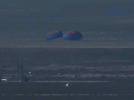Almost a cut-and-paste from the FAA guide…When a helicopter is being maneuvered, its disk loading changes. The higher the loading, the more power needed to maintain rotor speed. A low disk loading is a direct indicator of high lift thrust efficiency. Increasing the weight of a helicopter increases disk loading. For a given weight, a helicopter with shorter rotors will have higher disk loading, and will require more engine power to hover. A low disk loading improves autorotation performance.If you have two rotary-wing aircraft and one has three or four times as much disc loading as the other aircraft (but everything else is the same), is their autorotation performance fundamentally different?
If the answer is "Go read the FAA guide on helicopters", feel free to tell me that
But…in an autorotation it is all about the best vertical descent rate (typically, I think, close to the Vy, rate of climb, for the craft). On the Griz-O-Copter, anssuming average weight and standard day weather, the descent rate is a very comfortable 60 MPH IAS (about 1800 fpm). However, if you lower the nose and increase the forward IAS to 100MPH (just above Vne power off), the vertical descent rate almost double to 3300 fpm. At that rate the rotor RPM is struggling to even touch the lower portion of the green arc resulting in an unusually fast and perhaps an uncontrollable vertical descent rate - in short you’ll have no energy at the bottom to slow down. There is a fun, and terrifying, training routine where you enter an auto at about 1000 feet and drop at 100MPH…about half way down you yank the nose back until it is nearly pointing straight up and slow to 20MPH and then lower the nose to hit 60 MPH and head on in!






